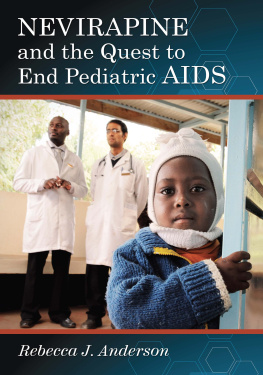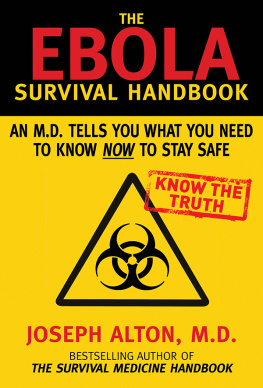The information given in this volume is for educational and entertainment purposes only and does not constitute medical advice or the practice of medicine. No provider-patient relationship, explicit or implied, exists between the publisher, authors, and readers. This book does not substitute for such a relationship with a qualified provider. The strategies discussed in this volume are based on current knowledge; advances in our understanding of prevention, care, and treatment of Zika virus may change significantly in the future. The authors and publisher strongly urge their readers to seek modern and standard medical care with certified practitioners whenever and wherever it is available.
The reader should never delay seeking medical advice, disregard medical advice, or discontinue medical treatment because of information in this book or any resources cited in this book.
Although the authors have researched all sources to ensure accuracy, they assume no responsibility for errors, omissions, or other inconsistencies therein. Neither do the authors or publisher assume liability for any harm caused by the use or misuse of any methods, products, instructions, or information in this book or any resources cited in this book.
Copyright 2016 by Skyhorse Publishing
All rights reserved. No part of this book may be reproduced in any manner without the express written consent of the publisher, except in the case of brief excerpts in critical reviews or articles. All inquiries should be addressed to Skyhorse Publishing, 307 West 36th Street, 11th Floor, New York, NY 10018.
Skyhorse Publishing books may be purchased in bulk at special discounts for sales promotion, corporate gifts, fund-raising, or educational purposes. Special editions can also be created to specifications. For details, contact the Special Sales Department, Skyhorse Publishing, 307 West 36th Street, 11th Floor, New York, NY 10018 or .
Skyhorse and Skyhorse Publishing are registered trademarks of Skyhorse Publishing, Inc., a Delaware corporation.
Visit our website at www.skyhorsepublishing.com.
10 9 8 7 6 5 4 3 2 1
Library of Congress Cataloging-in-Publication Data is available on file.
Cover design by Brian Peterson
Cover photo by iStockPhoto.com
Print ISBN: 978-1-5107-2220-0
Ebook ISBN: 978-1-5107-2221-7
Printed in the United States of America
Contents
FOREWORD
BY LAURA D. KRAMER, PHD, FASTMH
Acknowledgements
E very book is a team effort, and I first would like to thank the team at Hollan Publishing, especially Holly Schmidt and Monica Sweeney, for their help, encouragement, and advice. Thanks are also due to the publisher, Skyhorse.
This book also owes a great debt to the men and women of the Centers for Disease Control and Prevention, who have issued great information and guidelines on the Zika virus, some of which is excerpted or adapted for this book. Their hard work is not only saving lives, but is also responsible for much of the information and content in this book.
Thanks are also due to Laura Kramer for her great foreword and for helping improve the text. I would also like to thank Hans Verkerke, who helped me clarify some issues that arose while writing the book.
As a writer, I have been extremely fortunate to receive extremely valuable advice, encouragement, and mentorship from John Thompson. I would also like to thank Amy Gary, who has supported my career and freely shared her detailed knowledge of the industry. I would also like to thank Nguyen An, Noah Davis, Tom Grundy, Kristin Wong, Stuart Thornton, and Isak Ladegaard for sharing their writing expertise with me.
All along Ive been fortunate to have support and encouragement from my friends around the world, including (but certainly not limited to): Alan Gregory, Greg Leichner, Jeffrey Leung, Linda and Richard Barr, Mark Erhart, Matt Chambers, Patrick Bostrom, Peter Chan, Peter Farrell, Phillip Walker, Pratyush Rai, Rob Martin, Ryohei Mizusawa, Sonny Dhanda, Takuya Kon, Will Massie, Zach Parks, KJ Yoo, the Spiekermann family, Pei Wang, and many, many, more.
I would also like to thank two teachers who have had a positive impact on my life, Baniel Cheung and Chris Bunin.
Finally, I would like to thank my family and relatives, including Vanessa and the entire Cao family, for all the love and support they have provided me over the years. That is truly the greatest gift of all.
Foreword
Z ika virus is an arbovirus (arthropod-borne virus), which is a type of virus that passes most commonly between mosquitoes, sand flies, or ticks to humans and other species. Zika virus is carried by Aedes aegypti mosquitoes, the same species commonly associated with the spread of yellow fever, dengue, and chikungunya viruses. Not only are these viruses carried by the same mosquito, they have similar early symptoms in infected humans, making it difficult to diagnose which disease the patient has. Zika, however, while generally a mild illness, is particularly dangerous because it causes microcephaly and other neurologic disorders in babies infected in the womb. It also has been associated with increased numbers of cases in adults of Guillain-Barre syndrome, an autoimmune disorder affecting the peripheral nervous system following infection with a virus. Joint and ocular problems have been reported along with other abnormalities following Zika infection.
Zika virus is expanding its range at a rapid pace, which is having major global consequences. Currently in the summer of 2016, Zika virus is causing increasing numbers of cases in Florida, and appears to be spreading to other states such as Texas, and countries such as Taiwan, through viremic travelers.
It is not a question of whether a new arbovirus like Zika will emerge, but rather what will the new disease be, and when it will happen. In retrospect, we should have been able to predict the emergence of most of the mosquito-borne viruses that have come our way. In the past, viruses such as West Nile and dengue were not regarded as threats until they reached the US In fact, most people in the US had never even heard of West Nile virus! After West Nile arrived to fertile ground in New York in 1999, the virus flourished and spread from the east to west coast in approximately three years. Similarly, dengue has been increasing as a problem for the Americas. Over 2.5 billion people, greater than 30 percent of the worlds population, in over 100 countries are at risk of dengue infection. There are annually scattered cases in the US, with an outbreak in Florida in 20092010. There is concern that climate warming may contribute to the expansion of the vectors range, and consequently, increasing numbers of cases.
Why are we seeing emergence of a growing number of viruses with serious medical consequences? The factors leading to this trend are many, including socio-economic, environmental, and ecological. The globalization of goods, rapid international travel by large numbers of people, and destruction of habitat bring humans into close contact with viruses. Land use changes such as urbanization, agricultural, and deforestation have significant impact on vector-borne disease. One example of this is the clearing of forests to build roads and houses, which brings down canopy-dwelling mosquitoes that normally would feed on non-human primates in the tree tops but, with cutting down trees, feed on humans at ground level. Furthermore, such destructive activities create new habitats for vectors, such as pools of water for mosquito breeding. Patterns of malaria and yellow fever, for example among others, have been affected by deforestation. Whats more, urban crowding with inadequate infrastructure to support the growing population, lack of clean drinking water, poor water storage, ineffective mosquito control, and lack of approved, safe vaccines and therapeutics can all contribute to the increased spread of viruses like Zika.












